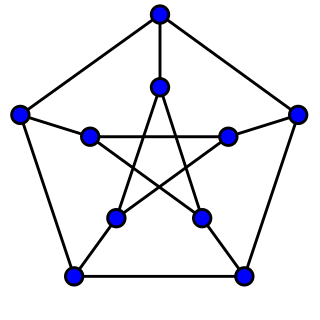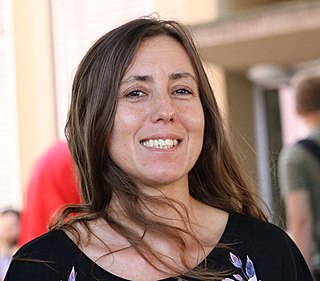Related Research Articles

Dragan Marušič is a Slovene mathematician. Marušič obtained his BSc in technical mathematics from the University of Ljubljana in 1976, and his PhD from the University of Reading in 1981 under the supervision of Crispin Nash-Williams.

In the mathematical field of graph theory, the Petersen graph is an undirected graph with 10 vertices and 15 edges. It is a small graph that serves as a useful example and counterexample for many problems in graph theory. The Petersen graph is named after Julius Petersen, who in 1898 constructed it to be the smallest bridgeless cubic graph with no three-edge-coloring.
Combinatorics is a branch of mathematics concerning the study of finite or countable discrete structures.
In the mathematical field of graph theory, a vertex-transitive graph is a graph G in which, given any two vertices v1 and v2 of G, there is some automorphism

Algebraic graph theory is a branch of mathematics in which algebraic methods are applied to problems about graphs. This is in contrast to geometric, combinatoric, or algorithmic approaches. There are three main branches of algebraic graph theory, involving the use of linear algebra, the use of group theory, and the study of graph invariants.

In graph theory, a circulant graph is an undirected graph acted on by a cyclic group of symmetries which takes any vertex to any other vertex. It is sometimes called a cyclic graph, but this term has other meanings.

Cheryl Elisabeth Praeger is an Australian mathematician. Praeger received BSc (1969) and MSc degrees from the University of Queensland (1974), and a doctorate from the University of Oxford in 1973 under direction of Peter M. Neumann. She has published widely and has advised 27 PhD students. She is currently Emeritus Professor of Mathematics at the University of Western Australia. She is best known for her works in group theory, algebraic graph theory and combinatorial designs.

Václav (Vašek) Chvátal is a Professor Emeritus in the Department of Computer Science and Software Engineering at Concordia University in Montreal, Quebec, Canada, and a visiting professor at Charles University in Prague. He has published extensively on topics in graph theory, combinatorics, and combinatorial optimization.
The mathematical field of combinatorics was studied to varying degrees in numerous ancient societies. Its study in Europe dates to the work of Leonardo Fibonacci in the 13th century AD, which introduced Arabian and Indian ideas to the continent. It has continued to be studied in the modern era.

In graph theory, a branch of mathematics, a Hamiltonian decomposition of a given graph is a partition of the edges of the graph into Hamiltonian cycles. Hamiltonian decompositions have been studied both for undirected graphs and for directed graphs. In the undirected case a Hamiltonian decomposition can also be described as a 2-factorization of the graph such that each factor is connected.
Norman Linstead Biggs is a leading British mathematician focusing on discrete mathematics and in particular algebraic combinatorics.
In combinatorial mathematics, Toida's conjecture, due to Shunichi Toida in 1977, is a refinement of the disproven Ádám's conjecture from 1967.
Daniela Kühn is a German mathematician and the Mason Professor in Mathematics at the University of Birmingham in Birmingham, England. She is known for her research in combinatorics, and particularly in extremal combinatorics and graph theory.
Brian Roger Alspach is a mathematician whose main research interest is in graph theory. Alspach has also studied the mathematics behind poker, and writes for Poker Digest and Canadian Poker Player magazines.
Katherine A. Heinrich is a mathematician and mathematics teacher who was the first female president of the Canadian Mathematical Society. Her research interests include graph theory and the theory of combinatorial designs. Originally from Australia, she moved to Canada where she worked as a professor at Simon Fraser University and as an academic administrator at the University of Regina.

Klavdija Kutnar is a Slovene mathematician. She received her PhD at the University of Primorska (UP) in 2008, and she currently serves as the Rector of the university.
Pearls in Graph Theory: A Comprehensive Introduction is an undergraduate-level textbook on graph theory by Nora Hartsfield and Gerhard Ringel. It was published in 1990 by Academic Press with a revised edition in 1994 and a paperback reprint of the revised edition by Dover Books in 2003. The Basic Library List Committee of the Mathematical Association of America has suggested its inclusion in undergraduate mathematics libraries.
Convex Polytopes is a graduate-level mathematics textbook about convex polytopes, higher-dimensional generalizations of three-dimensional convex polyhedra. It was written by Branko Grünbaum, with contributions from Victor Klee, Micha Perles, and G. C. Shephard, and published in 1967 by John Wiley & Sons. It went out of print in 1970. A second edition, prepared with the assistance of Volker Kaibel, Victor Klee, and Günter M. Ziegler, was published by Springer-Verlag in 2003, as volume 221 of their book series Graduate Texts in Mathematics.
References
- ↑ Birth year from WorldCat Identities, retrieved 2019-08-26.
- 1 2 3 "Dr. Joy Morris", STEM from the Prairies, NSERC Chair for Women in Science & Engineering, archived from the original on 2018-12-10, retrieved 2019-08-26
- 1 2 3 4 5 6 "Interview with Joy Morris", Mathematics with a Human Face, Math Central, May 2017, retrieved 2019-08-26
- 1 2 "Joy Morris", Campus Directory, University of Lethbridge, retrieved 2019-08-26
- ↑ Joy Morris at the Mathematics Genealogy Project
- ↑ Scarpelli, Joe (January 19, 2018), Lethbridge parents join middle school math class to keep up with their kids, Global News
- ↑ Kalinowski, Tim (February 3, 2019), "U of L offering Math Help Sessions for Parents", Lethbridge Herald, archived from the original on February 3, 2019
- ↑ Review of Morris's paper "Toida's conjecture is true" (with Edward Dobson, Elect. J. Combin. 2002): Seifter, Norbert (2003), MR 1928787
- ↑ "Proofs and Concepts", Open Textbook Library, Center for Open Education, University of Minnesota College of Education and Human Development, retrieved 2019-08-26
- ↑ "Combinatorics", Open Textbook Library, Center for Open Education, University of Minnesota College of Education and Human Development, retrieved 2019-08-26